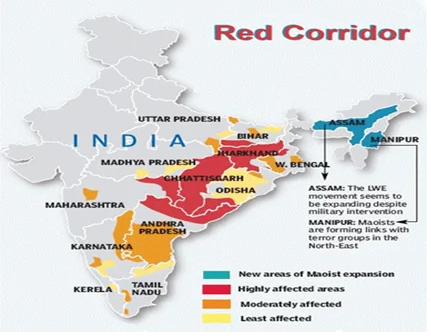Left Wing Extremism (GS Paper 3, Internal Security)

Why in News?
- Recently, two separate incidents of Naxalite attacks were reported: In the Kanker area of Chhattisgarh, security forces conducted one of the largest operations, resulting in the killing of 29 Naxalites.
- In eastern Assam’s Tinsukia district, three vehicles of the paramilitary Assam Rifles were ambushed in another incident.
Understanding Naxalism: Causes, Impact, and Government Initiatives
Origin of Naxalism:
- The term "Naxalism" originates from the village Naxalbari in West Bengal, where it began as a rebellion against local landlords following a land dispute incident.
- The movement quickly spread across Eastern India, particularly in underdeveloped regions of states like Chhattisgarh, Odisha, and Andhra Pradesh.
- Left-wing extremists associated with Naxalism are globally known as Maoists and in India as Naxalites.
Objectives of Naxalism:
- Naxalites advocate for the armed overthrow of the Indian government and the establishment of a communist state based on Maoist principles.
- They perceive the state as oppressive and serving the interests of the ruling elite, seeking to address socio-economic grievances through armed struggle and people's war.
Modus Operandi of Naxalites:
- Naxalite groups engage in guerrilla warfare, attacks on security forces, extortion, intimidation, and propaganda.
- They aim to capture state power through armed insurgency, mass mobilization, and strategic alliances, targeting government institutions, infrastructure, and economic interests.
- In areas under their control, Naxalites establish parallel governance structures, providing basic services and dispensing justice.
Status of Left-Wing Extremism (LWE) in India:
- Violent incidents in Naxalism-affected states have significantly decreased, with a 77% reduction in 2022 compared to the peak in 2010.
- The number of affected districts dropped from 90 to 45, and deaths of security forces and civilians in LWE violence decreased by 90%.
- States Affected by LWE: Chhattisgarh, Jharkhand, Odisha, Bihar, West Bengal, Andhra Pradesh, Telangana, Maharashtra, Madhya Pradesh, and Kerala.
Causes of Naxalism:
Socio-Economic Factors:
- High poverty rates and lack of development in underdeveloped regions.
- Displacement of indigenous communities (Adivasis) from their traditional lands due to mining and development projects.
- Exploitation of tribal communities by powerful entities.
- Caste discrimination, particularly against Dalits.
Political Factors:
- Weak governance and lack of infrastructure in Naxalism-affected areas.
- Disillusionment with democracy and failure of the democratic system to address grievances.
Initiatives of the Government Against Naxalism:
- National Policy and Action Plan to address Left-Wing Extremism.
- Initiatives like SAMADHAN, Aspirational Districts Programme, Security Related Expenditure (SRE) Scheme, and Special Central Assistance (SCA) for LWE-affected districts.
- Projects for fortifying police stations, improving road connectivity, and enhancing socio-economic development in affected areas.
Way Forward:
- Targeted security operations using intelligence-based approaches.
- Rehabilitation and reintegration of former extremists.
- Empowering local peace ambassadors and fostering open communication channels.
- Promoting socio-economic development and ecological sustainability in affected areas.


